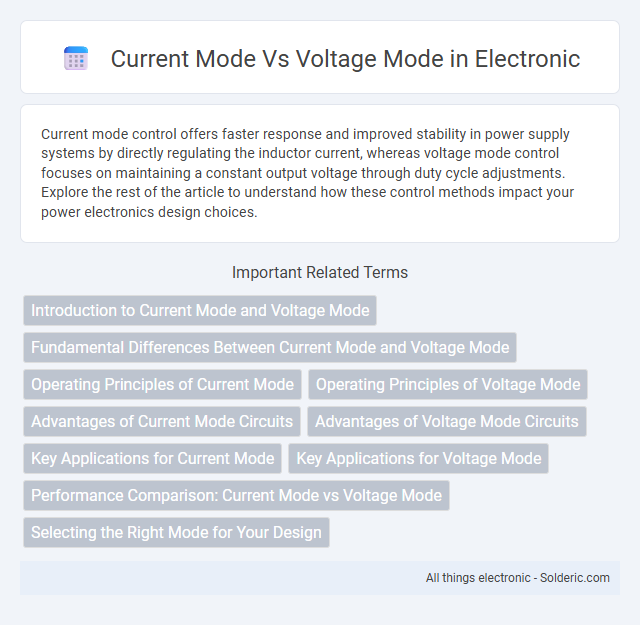Current mode control offers faster response and improved stability in power supply systems by directly regulating the inductor current, whereas voltage mode control focuses on maintaining a constant output voltage through duty cycle adjustments. Explore the rest of the article to understand how these control methods impact your power electronics design choices.
Comparison Table
| Feature | Current Mode Control | Voltage Mode Control |
|---|---|---|
| Control Variable | Inductor current | Output voltage |
| Loop Response | Faster, current loop stabilizes inner loop | Slower, single voltage feedback loop |
| Complexity | More complex, requires current sensing | Simpler, voltage sensing only |
| Noise Sensitivity | Less susceptible due to current feedback | More prone to noise due to voltage sensing |
| Output Ripple | Lower output ripple, better regulation | Higher output ripple |
| Stability | Improved stability with slope compensation | Potential subharmonic oscillations at duty > 50% |
| Applications | High-performance DC-DC converters, complex loads | Simple power supplies, low-cost designs |
Introduction to Current Mode and Voltage Mode
Current mode control regulates the output by directly controlling the inductor current, offering faster response to load changes and inherent overcurrent protection. Voltage mode control adjusts the duty cycle based on the output voltage error, providing simpler design and better noise immunity in stable conditions. Both methods are fundamental in power electronics, with current mode often preferred for dynamic performance and voltage mode favored for straightforward implementation.
Fundamental Differences Between Current Mode and Voltage Mode
Current mode control regulates the inductor current directly, enabling faster transient response and inherent overcurrent protection, while voltage mode control regulates the output voltage through duty cycle adjustments based on voltage feedback. Voltage mode relies on a single feedback loop comparing output voltage, leading to simpler implementation but potentially slower response to load changes. Current mode introduces an inner current loop that improves stability and reduces output voltage ripple, making it suitable for high-performance power converters.
Operating Principles of Current Mode
Current mode control regulates the output by directly controlling the inductor current, providing faster response to load changes and inherent cycle-by-cycle current limiting. It samples the inductor current and compares it to a reference value, adjusting the duty cycle of the switch to maintain the desired current level. This operating principle enhances stability and simplifies compensation compared to voltage mode control.
Operating Principles of Voltage Mode
Voltage mode control operates by regulating the output voltage of a power converter through a feedback loop that compares the output voltage to a reference voltage, adjusting the duty cycle accordingly. This approach uses an error amplifier to process the voltage difference and modulate the pulse width of the switching device, ensuring stable and accurate voltage delivery. Your power supply system benefits from smooth voltage regulation under varying load conditions, making voltage mode control ideal for applications requiring precise voltage stability.
Advantages of Current Mode Circuits
Current mode circuits offer faster response times and improved stability due to their direct control of inductor current, reducing the complexity of feedback loops. They provide inherent cycle-by-cycle current limiting, enhancing protection and reliability in power systems. Your designs benefit from simplified compensation requirements and better performance under varying load conditions.
Advantages of Voltage Mode Circuits
Voltage mode circuits offer superior stability and ease of control, making them ideal for applications requiring precise voltage regulation. They provide faster transient response due to their straightforward feedback loops and are less susceptible to noise interference compared to current mode circuits. These advantages contribute to improved overall performance in power supply and analog signal processing systems.
Key Applications for Current Mode
Current mode control is extensively used in switch-mode power supplies due to its inherent over-current protection and fast transient response capabilities. It is preferred in DC-DC converters for applications requiring precise current regulation, such as battery chargers and LED drivers. This mode enhances system stability by directly controlling the inductor current, making it ideal for high-frequency and high-performance power management in communication and industrial systems.
Key Applications for Voltage Mode
Voltage mode control is widely used in applications requiring precise voltage regulation such as DC-DC converters, linear regulators, and power supplies for sensitive electronics. It offers simplicity and stability, making it ideal for systems where fast transient response and accurate output voltage are critical. Your design will benefit from voltage mode control in LED drivers, battery chargers, and low-noise audio equipment.
Performance Comparison: Current Mode vs Voltage Mode
Current mode control offers faster response and improved loop stability compared to voltage mode, making it ideal for high-performance power converters. Voltage mode control provides simpler implementation and better noise immunity but may suffer from slower transient response and less precise current regulation. Your choice between the two depends on the specific application requirements, including speed, complexity, and load conditions.
Selecting the Right Mode for Your Design
Choosing between current mode and voltage mode control depends on your design's specific requirements for stability, response time, and complexity. Current mode offers superior cycle-by-cycle overcurrent protection and faster transient response, ideal for applications needing precise current regulation and reduced output inductance effects. Voltage mode simplifies compensation and provides better noise immunity, making it suitable for designs prioritizing steady voltage output and less sensitivity to input voltage variations.
Current mode vs Voltage mode Infographic

 solderic.com
solderic.com